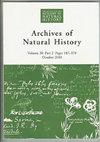The illustrated natural history lectures of Benjamin Waterhouse Hawkins given in Britain, 1850s–1880s
IF 0.2
4区 哲学
Q3 HISTORY & PHILOSOPHY OF SCIENCE
引用次数: 0
Abstract
Benjamin Waterhouse Hawkins (1807–1894), celebrated in Britain and the United States for his models and illustrations of extinct animals, also had an extensive lecturing career. This paper discusses the reports of Hawkins’s lectures in Britain, delivered between the 1850s and the early 1880s. Unabbreviated transcriptions of his lectures are rare, but newspaper reports are numerous. Hawkins spoke on comparative anatomy, geology, palaeontology and art, his most prominent themes being the origin of dragon myths and the impossibility of human evolution. Above all, he was known for his ability to sketch natural forms rapidly and accurately as he spoke. Hawkins saw significant success in metropolitan centres, but he also built rewarding relationships with provincial towns. This allowed for substantial engagement with civic scientific communities, whose fossil specimens were used by Hawkins and whose local science initiatives were promoted in press accounts of his lectures. Hawkins’s fervent anti-evolutionism aroused attention, although his alternative explanation of life’s development, “the unity of plan”, led to some confusion, and he became embittered by the spread of evolutionary naturalism. Hawkins’s career faded in the 1880s, but memories of his lecturing style lingered with audiences at the century’s close.本杰明-沃特豪斯-霍金斯 1850-1880 年代在英国举办的图文并茂的自然历史讲座
本杰明-沃特豪斯-霍金斯(1807-1894 年)因其制作的灭绝动物模型和插图在英国和美国享有盛誉,同时他还拥有广泛的演讲生涯。本文讨论的是霍金斯于 19 世纪 50 年代至 19 世纪 80 年代早期在英国发表的演讲报告。霍金斯演讲的简短记录非常罕见,但报纸报道却很多。霍金斯的演讲涉及比较解剖学、地质学、古生物学和艺术,他最突出的主题是龙神话的起源和人类进化的不可能性。最重要的是,他以能够边讲边快速准确地勾勒自然形态而闻名。霍金斯在大都市中心取得了巨大成功,但他也与外省城镇建立了有益的关系。霍金斯使用了这些城镇的化石标本,当地的科学活动也在霍金斯讲座的新闻报道中得到了推广。霍金斯狂热的反进化论引起了人们的关注,尽管他对生命发展的另一种解释--"计划的统一性"--导致了一些混乱,而且他对自然进化论的传播感到愤慨。19 世纪 80 年代,霍金斯的事业逐渐衰落,但他的演讲风格在世纪末仍让听众记忆犹新。
本文章由计算机程序翻译,如有差异,请以英文原文为准。
求助全文
约1分钟内获得全文
求助全文
来源期刊

Archives of Natural History
HISTORY & PHILOSOPHY OF SCIENCE-
CiteScore
0.40
自引率
50.00%
发文量
34
审稿时长
>12 weeks
期刊介绍:
Archives of Natural History (formerly the Journal of the Society for the Bibliography of Natural History) publishes peer-reviewed papers on the history and bibliography of natural history in its broadest sense, and in all periods and all cultures. This is taken to include botany, general biology, geology, palaeontology and zoology, the lives of naturalists, their publications, correspondence and collections, and the institutions and societies to which they belong. Bibliographical papers concerned with the study of rare books, manuscripts and illustrative material, and analytical and enumerative bibliographies are also published.
 求助内容:
求助内容: 应助结果提醒方式:
应助结果提醒方式:


